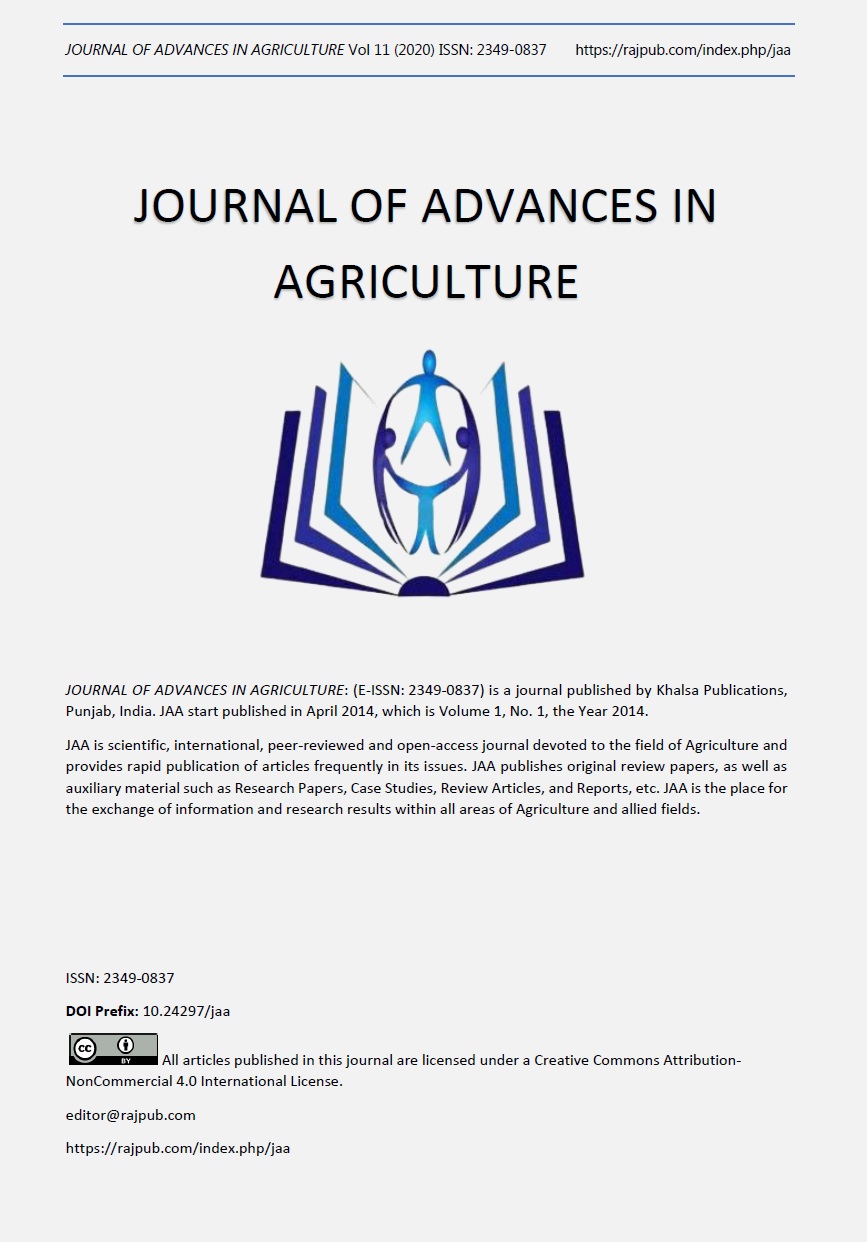Preliminary in Vitro Investigations on The Inhibitory Activity of The Original Dietary Supplement Oxidal® on Pathogenic Bacterial Strains
DOI:
https://doi.org/10.24297/jaa.v11i.8693Keywords:
Oxidal®, Staphylococcus Aureus, Escherichia Coli, Antibacterial ActivityAbstract
The antimicrobial action of the dietary supplement Oxidal® was tested using the classic Bauer and Kirby agar-gel diffusion method. Clinical and reference strains of Staphylococcus aureus and Escherichia coli were used in the studies. The tested dietary supplement showed a well-pronounced inhibitory effect against the microbial strains commensurable with that of the broad-spectrum chemotherapeutic agent Enrofloxacin and showed even higher activity than the broad spectrum antibiotic Thiamphenicol. The proven inhibitory effect of the tested dietary supplement against the examined pathogenic bacteria is in accordance with the established clinical effectiveness standards for antimicrobial agents.
Downloads
References
Bauer, A. W., W. M. Kirby, J. C. Cherris, M. Truck. (1966). Antibiotic susceptibility testing by a standardized single disk method. The Am. J. of Clin. Pathol. Vol. 45. No 4. P. 493 – 496. https://doi.org/10.1093/ajcp/45.4_ts.493
Deiana, S. (2009) Methylthioninium chloride reverses cognitive deficits induced by scopolamine: comparison with rivastigmine, Psychopharmacology (Berl). 202, 1-3, 53-65. DOI: 10.1007/s00213-008-1394-2. https://doi.org/10.1007/s00213-008-1394-2
Floyd R.A.; Schneider J.E.; Dittmer D.P. (2004). Methylene blue photoinactivation of RNA viruses. Antiviral Res. 61 (3): 141–51. DOI:10.1016/j.antiviral.2003.11.004. PMID 15168794. https://doi.org/10.1016/j.antiviral.2003.11.004
Gluhchev, G., Ignatov, I., Karadzhov, S., Miloshev, G., Ivanov, I., Mosin, O. V. (2015) Studying of Virucidal and Biocidal Effects of Electrochemically Activated Anolyte and Catholyte Types of Water on Classical Swine Fever Virus (CSF) and Bacterium E. coli DH5, Journal of Medicine, Physiology and Biophysics, 13: 1-17.
Ignatov, I., Gluhchev, G., Karadzhov, G., Yaneva, I., Valcheva, N., Dinkov, G., Popova, T., Petrova, T., Mehandjiev, D., Akszjonovich, I. (2020). Dynamic Nano Clusters of Water on Waters Catholyte and Anolyte: Electrolysis with Nano Membranes, Physical Science International
Journal, 24, 1, 46-54. https://doi.org/10.9734/psij/2020/v24i130173
Ignatov, I., Mosin, O. V. (2013) Structural Mathematical Models Describing Water Clusters, Journal of Mathematical Theory and Modeling, 3 (11): 72-87.
Karadzov, S., Atanasov, A., Ivanova, E., Mosin, O. V., Ignatov, I. (2014) Mathematical Models of Electrochemical Aqueous Sodium Chloride Solutions (Anolyte and Catolyte) as Types of Water. Study of the Effects of Anolyte on the Virus of Classical Swine Fever Virus, Journal of Health, Medicine and Nursing, 5, 30-55.
Meissner, P. M., G. Mandi, B. Coulibaly, S. Witte, T. Tapsoba, U. Mansmann, J. Rengelshausen, W. Schiek, A. Jahn, I. Walter-Sack, G. Mikus, J. Burhenne, K.-D. Riedel, R H. Schirmer, B. Kouyaté, and O. Müller. (2006). Methylene blue for malaria in Africa: results from a dose-finding study in combination with chloroquine. Malaria Journal. 5: 84.. PMC 1617109. PMID 17026773. https://doi.org/10.1186/1475-2875-5-84
National Committee for Clinical Laboratory Standards: Performance Standards for Antimicrobial Disk Susceptibility Tests. 6-th ed. Approved Standard. NCCLS Document M2 – A6, 17, 1, 1997.
National Committee for Clinical Laboratory Standards: Performance Standards for Antimicrobial Susceptibility Testing: Ninths Informational Supplement. NCCLS Document M100 – S9, 18, 1, 1999.
Papin J.F.; Floyd R.A.; Dittmer D.P. (2005). Methylene blue photoinactivation abolishes West Nile virus infectivity in vivo. Antiviral Res. 68 (2): 84–7. PMID 16118025. https://doi.org/10.1016/j.antiviral.2005.07.001
Popova, T. P., T. Petrova, and S. Karadzhov. (2016 a). Investigation of the Biocidal Effect of Electrochemically Activated Aqueous Sodium Chloride Solution on Gram-negative Pathogenic Bacteria. Int. J. Curr. Microbiol. App. Sci., 5, 1, 624-632. ISSN: 2319-7692, 2319-7706. https://doi.org/10.20546/ijcmas.2016.501.063
Popova, T. P., T. Petrova, S. Karadzhov, and G. Krustanova. (2016 b). Investigation of the Biocidal Effect of Electrochemically Activated Aqueous Sodium Chloride Solution on Staphylococcus aureus. Traditions and modernity in veterinary medicine, Scientific Journal of the Faculty of Veterinary Medicine of University of Forestry, Sofia, 1, 1, 67-72. ISSN 2534-9333, e- ISSN 2534-9341.
Prosed D. S. (2011). (Methenamine, Salicylate, Methylene Blue, Benzoic Acid Atropine and Hyoscyamine) Drug Information: Description, User Reviews, Drug Side Effects, Interactions - Prescribing Information at RxList. RxList. Archived from the original on 2011-11-02. https://www.rxlist.com/prosed-ds-drug.htm
Suzuki, T., Itakura, J., Watanabe, M., Ohta, M., Sato, Y., Yamata, Y. (2002) Inactivation of Staphylococcal Enterotoxin-A with an Electrolyzed Anodic Solution. Journal of Agricultural and Food Chemistry; 50: 230–234. https://doi.org/10.1021/jf010828k
Tardivo J.P.; Del Giglio A.; Paschoal L.H.; Baptista M.S. (2006). New photodynamic therapy protocol to treat AIDS-related Kaposi's sarcoma. Photomedical Laser Surg. 24 (4): 528–31. PMID 16942436 https://doi.org/10.1089/pho.2006.24.528
Wagner, S. J. (2002). Virus inactivation in blood components by photoactive phenothiazine dyes. Transfusion Medicine Reviews,16, 1, 61-66. https://doi.org/10.1053/tmrv.2002.29405
Wagner S.J.; Skripchenko A.; Robinette D.; Mallory D.A.; Hirayama J.; Cincotta L.; Foley J. (2000). The use of dimethyl methylene blue for virus photoinactivation of red cell suspensions. Dev. Biol. (Basel). 102: 125–9. PMID 10794099.
World Health Organization (2019). World Health Organization model list of essential medicines: 21st list 2019. Geneva: World Health Organization. hdl:10665/325771. WHO/MVP/EMP/IAU/2019.06. License: CC BY-NC-SA 3.0 IGO.
Zolfaghari P.S.; Packer S.; Singer M.; Nair S.P.; Bennett J.; Street C.; Wilson M. (2009). In vivo killing of Staphylococcus aureus using a light-activated antimicrobial agent. BMC Microbiol. 9: 27. PMC 2642833. PMID 19193212. https://doi.org/10.1186/1471-2180-9-27
Downloads
Published
How to Cite
Issue
Section
License
 All articles published in Journal of Advances in Linguistics are licensed under a Creative Commons Attribution 4.0 International License.
All articles published in Journal of Advances in Linguistics are licensed under a Creative Commons Attribution 4.0 International License.




